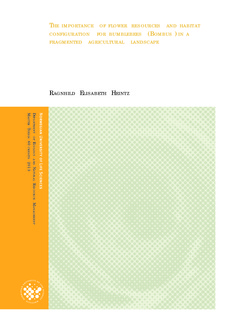| dc.contributor.author | Heintz, Ragnhild Elisabeth | |
| dc.date.accessioned | 2013-08-23T09:13:45Z | |
| dc.date.available | 2013-08-23T09:13:45Z | |
| dc.date.copyright | 2013 | |
| dc.date.issued | 2013-08-23 | |
| dc.identifier.uri | http://hdl.handle.net/11250/187013 | |
| dc.description.abstract | Bumblebees are important pollinators of crops and wild flowers, and the observed decrease in
natural bumblebee populations are therefore an increasing cause of concern. The aim of this
thesis was to evaluate how bumblebees are affected by different variables in the fragmented
landscape. The questions raised were if the density of flowering plants and habitat
configuration could explain the species richness, abundance and size of bumblebees.
Questions about preferred forage plant species were also addressed. The study was conducted
during the summer of 2012 in south-east Norway, which has a landscape dominated by a
mixture of intensive cereal production and coniferous forests. 13 different species of
bumblebees were found in this area and the results showed that the total abundance and
species richness of social bumblebees were positively influenced by the density of flowering
plants. Results show no significant effects of area, circumference or type of remnant on
species richness, abundance or size of bumblebees. The preferred plant species for
bumblebees in general were preferred by all observed species. Between casts, differences in
preferred plant species were found. The results also indicate that bumblebees prefer perennial
plants over annuals. | no_NO |
| dc.language.iso | eng | no_NO |
| dc.publisher | Norwegian University of Life Sciences, Ås | |
| dc.title | The importance of flower resources and habitat configuration for bumblebees (Bombus) in a fragmented agricultural landscape | no_NO |
| dc.type | Master thesis | no_NO |
| dc.subject.nsi | VDP::Mathematics and natural science: 400::Zoology and botany: 480 | no_NO |
| dc.source.pagenumber | 48 | no_NO |
